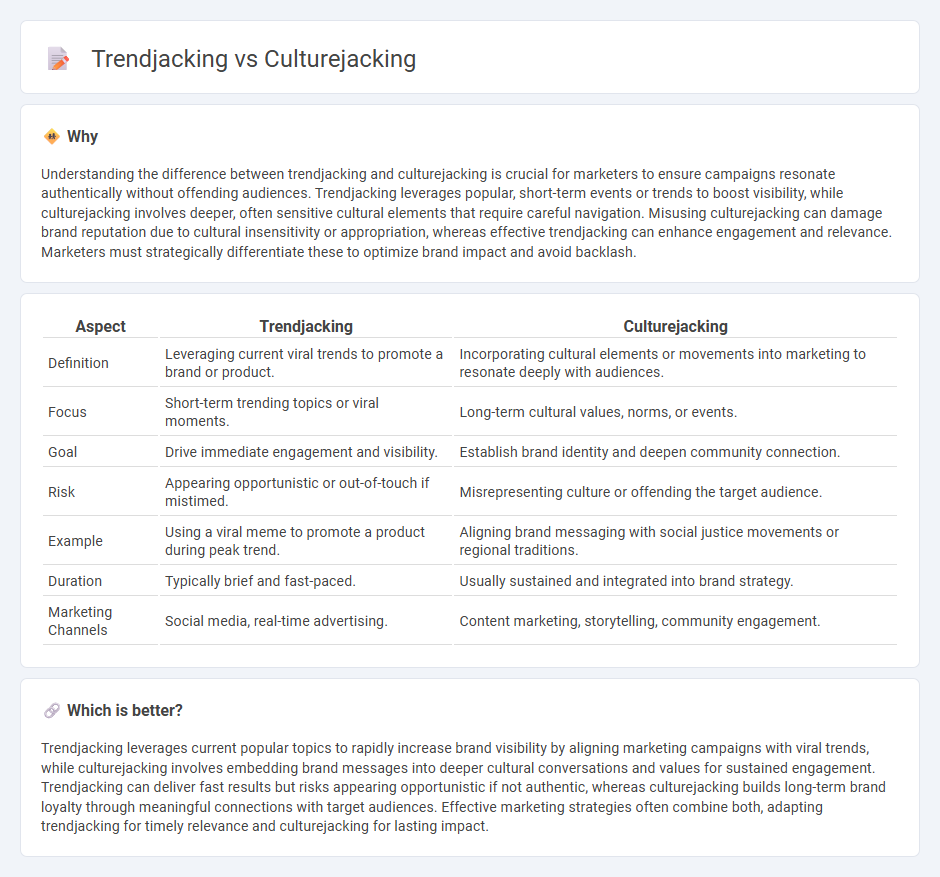
Trendjacking leverages current viral trends to quickly capture audience attention by aligning brand messages with popular topics, while culturejacking involves embedding marketing within broader cultural conversations or social movements to create deeper emotional connections. Both strategies require timely, relevant content that resonates authentically with target demographics to maximize engagement and brand visibility. Explore how these innovative marketing approaches can redefine your brand's connection with consumers.
Why it is important
Understanding the difference between trendjacking and culturejacking is crucial for marketers to ensure campaigns resonate authentically without offending audiences. Trendjacking leverages popular, short-term events or trends to boost visibility, while culturejacking involves deeper, often sensitive cultural elements that require careful navigation. Misusing culturejacking can damage brand reputation due to cultural insensitivity or appropriation, whereas effective trendjacking can enhance engagement and relevance. Marketers must strategically differentiate these to optimize brand impact and avoid backlash.
Comparison Table
| Aspect | Trendjacking | Culturejacking |
|---|---|---|
| Definition | Leveraging current viral trends to promote a brand or product. | Incorporating cultural elements or movements into marketing to resonate deeply with audiences. |
| Focus | Short-term trending topics or viral moments. | Long-term cultural values, norms, or events. |
| Goal | Drive immediate engagement and visibility. | Establish brand identity and deepen community connection. |
| Risk | Appearing opportunistic or out-of-touch if mistimed. | Misrepresenting culture or offending the target audience. |
| Example | Using a viral meme to promote a product during peak trend. | Aligning brand messaging with social justice movements or regional traditions. |
| Duration | Typically brief and fast-paced. | Usually sustained and integrated into brand strategy. |
| Marketing Channels | Social media, real-time advertising. | Content marketing, storytelling, community engagement. |
Which is better?
Trendjacking leverages current popular topics to rapidly increase brand visibility by aligning marketing campaigns with viral trends, while culturejacking involves embedding brand messages into deeper cultural conversations and values for sustained engagement. Trendjacking can deliver fast results but risks appearing opportunistic if not authentic, whereas culturejacking builds long-term brand loyalty through meaningful connections with target audiences. Effective marketing strategies often combine both, adapting trendjacking for timely relevance and culturejacking for lasting impact.
Connection
Trendjacking leverages current popular trends to create timely marketing content that resonates with audiences, while culturejacking taps into broader societal or cultural themes to craft messages that align with collective identities or values. Both strategies capitalize on existing public conversations to increase brand relevance and engagement by embedding marketing campaigns within the context of prevailing social dynamics. Effective use of trendjacking and culturejacking relies on deep understanding of audience sentiment and real-time cultural shifts to maximize impact and avoid backlash.
Key Terms
Real-time engagement
Culturejacking involves leveraging cultural moments or movements to create relevant marketing content, enhancing brand resonance through shared values and timely messaging. Trendjacking targets viral trends, memes, or popular hashtags to rapidly amplify visibility and engagement, capitalizing on fleeting online popularity. Explore how real-time engagement strategies differ and learn which approach best suits your brand's dynamic marketing objectives.
Brand relevance
Culturejacking leverages cultural movements and societal values to enhance brand relevance by aligning with consumer identity and social consciousness. Trendjacking captures emerging popular trends to generate immediate engagement and visibility while maintaining the brand's voice and appeal. Explore how strategic use of culturejacking and trendjacking can amplify your brand's relevance and drive market impact.
Audience resonance
Culturejacking leverages deep cultural symbols, values, or events to create authentic connections with niche audiences, enhancing brand relevance and trust. Trendjacking targets viral or emerging trends but risks audience fatigue due to its fleeting or opportunistic nature. Explore how mastering audience resonance through these strategies can elevate your marketing impact.
Source and External Links
The Ethics of 'Culture Jacking': Brand Fit vs Trends - Hello Partner - Culturejacking is when brands appropriate aspects of entertainment, music, and media trends for commercial purposes, often aiming to go viral on platforms like TikTok but sometimes facing backlash if the trend does not align with their core mission.
Understanding the So-Called 'Culture Jacking' of the Wicked Film Marketing Campaign - Cheddar - Culturejacking refers to marketing strategies where brands or campaigns leverage cultural trends or fan obsessions (such as popular films) to boost engagement and sales, with recent examples including the Wicked film and Barbie.
culture jacking Archives - Glint Advertising - Culturejacking has become a common practice for brands to capitalize on major pop culture events, like the Super Bowl, to increase brand awareness primarily on social media platforms.
 dowidth.com
dowidth.com